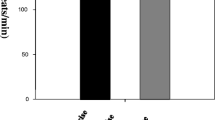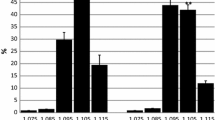Summary
Nine healthy subjects performed 2 different graded bicycle ergometric tests. The 1st test started with 50 watt and was increased 50 watt after 3 min till exhaustion as a model of a metabolic and cardiac exhaustion. The 2nd test started with 100 watt and was increased 50 watt after 15 min till exhaustion as a model of a peripheral-muscular exhaustion. The behaviour of plasma catecholamines, lactate and glucose levels, heart rate and oxygen intake was examined. The results were as following: Performance ability 305 (test 1) and 233 watt (test 2; mean values), work time 17.5 min (1) and 51 min (2), heart rate 185 min−1 (1) and 175 min−1 (2), noradrenaline 30.7 nmol/l (1) and 11.0 nmol/1 (2), adrenaline 6.9 nmol/l (1) and 2 nmol/1(2), lactate 9.2 (1) and 6.6 mmol/l (2), glucose 5.6 mmol/l (1) and 4.7 mmol/l (2). During highly intensive dynamic exercise (test 1), three times higher catecholamine and 50% higher lactate responses were observed, than during peripheral-muscular limited endurance exercise (test 2). Above an exercise level of more than 30% VO2 max., nor- and adrenaline increased significantly. Below 50–70% VO2 max. steady-state-behaviour occurred. Above this range unsteadystate-behaviour of plasma catecholamines was observed. Dopamine did not show any significant time and intensity dependent increase. Noradrenaline and adrenaline followed the same initial 1st order elimination kinetic.
Zusammenfassung
Neun Probanden absolvierten 2 unterschiedliche, stufenweise Fahrrad-Ergometerbelastungen im Sitzen. Test 1 begann mit 50 Watt und wurde nach 3 min um 50 Watt als Modell einermetabolisch-kardialen Ausbelastung gesteigert. Test 2 begann mit 100 Watt and wurde nach je 15 min um 50 Watt als Modell einerperipher-muskulären Ausbelastung gesteigert. Ermittelt wurden Plasmakatecholamine, Laktat- und Glukosespiegel, Herzfrequenz und O2-Aufnahme. Folgende Resultate (Mittelwerte) wurden bei Ausbelastung beobachtet. Belastung 305 (Test 1) and 233 Watt (Test 2), Arbeitszeit 17,5 min (1) and 51 min (2), Herzfrequenz 185 min−1 (1) and 175 min−1 (2), Noradrenalin 30,7 (1) and 11,0 (2), Adrenalin 6,9 (1) and 2,0 nmol · l−1 (2), Laktat 9,2 (1) and 6,6 (2), Glukose 5,6 (1) and 4,7 mmol · 1−1 (2). Hochintensive dynamische Körperarbeit (Test 1) geht mit mehrfach höherer Plasmakatecholaminkonzentration und Laktatazidose (Arbeitsazidose) einher als ausdauernde, peripher-muskulär limitierte Körperarbeit (Test 2); dies läßt einen erhöhten kardiovaskulären and metabolischen Stress erwarten. Oberhalb 30% VO2 max ist mit Nor- and Adrenalinanstieg zu rechnen; unterhalb 50–70% VO2 max wird Steady-state-Verhalten, darüber Unsteady-state-Verhalten beobachtet. Dopamin zeigt keine deutliche Zeit- and Belastungsabhängigkeit während Körperarbeit. Nor- and Adrenalin folgen derselben initialen Plasmaeliminationskinetik 1. Ordnung (e −0,048).
Similar content being viewed by others
Literatur
Da Prada M, Zurcher G (1976) Simultaneous radioenzymatic determination of plasma and tissue adrenaline, noradrenaline and dopamine within the fentomole range. Life Sci 19:1161–1174
Da Prada M, Zurcher G (1979) Radioenzymatic assay of plasma and urinary catecholamines in man and various animal species. Physiological and pharmacological applications. In: Albertini A, Prada M, Peskar BA (eds) Radioimmuno assay of drugs and hormones in cardiovascular medicine. Biochemical Press Elsevier North-Holland, Amsterdam, pp 112–119
Felig P (1973) The glucose-alanine cycle. Metabolism 22:179–207
Hartley LH, Mason JW, Hogan RP, Jones LG, Kotchen TA, Mougey EH, Wherry FE, Pennington LL, Ricketts PT (1972) Multiple hormonal responses to grased exercise in relation to physical training. J Appl Physiol 33: 602–606
Hohorst HJ (1962) L-(+)-Lactat. Bestimmung mit Lactatdehydrogenase and DPN. In: Bergmeyer HU (ed) Methoden der enzymatischen Analyse. Verlag Chemie, Weinheim, S 266–277
Kindermann W, Schmitt WM, Biro G, Schnabel A (1981) Metabolism und hormonelles Verhalten unter akuter Beta-1-Sympathikolyse. Z Kardiol 70:406–412
Lake CR, Ziegler MG, Coleman D, Kopin IJ (1977) Age-adjusted plasma norepinephrine levels are similiar in normotensive and hypertensive subjects. N Engl J Med 4: 208–209
Lehmann M, Keul J, Schmid P, Kindermann W, Huber G (1980) Plasmacatecholamine, Glucose, Lactat Bowie aerobe and anaerobe Kapazitat bei Jugendlichen. Dtsch Z Sportmed 31:287–295
Lehmann M, Keul J, Korsten-Reck U, Fischer H (1981) Einfluß der Ergometerarbeit im Liegen und Sitzen auf Plasmacatecholamine, metabolische Substrate Bowie Sauerstoffaufnahme und Herzfrequenz. Klin Wochenschr 59:1237–1242
Lehmann M, Keul J, Korsten-Reck U (1981) Einfluß einer stufenweisen Laufbandergometrie bei Kindern und Erwachsenen auf die Plasmacatecholamine, die aerobic und anaerobe Kapazitat. Eur J Appl Physiol 47: 301–311
Lehmann M, Keul J, Löllgen H, Just H (1981) Plasmakatecholamine und Hämodynamik bei gestörter linksventrikulärer Funktion in Rube und während Belastung. Z Kardiol 70:238–244
Lehmann M, Keul J, Huber G, Bachl N, Simon G (1981) Alters- und belastungsabhängiges Verhalten der Plasmacatecholamine. Klin Wochenschr 59:19–24
Lehmann M, Keul J, Huber G, Da Prada M (1981) Plasma catecholamines in trained and untrained volunteers during graduated exercise. Int J Sports Medicine 2:143–147
Lehmann M, Keul J (1982) Die Beziehung der Plasmakatecholamine zur Herzgröße, Förderleistung und zum Füllungsdruck des insuffizienten Herzens. Herz/Kreislauf 14: 142–148
Lehmann M, Keul J, Dickhuth HH (1982) Plasmacatecholamine und Hämodynamik bei Herzinsuffizienten. Herz 7:188–197
Lehmann M, Huber G, Spöri U, Keul J (1982) Katecholaminausscheidung bei körperlichen und konzentrativen Belastungen. Int Arch Occup Environ Health 50:175–186
Lehmann M, Wybitul K, Spöri U, Keul J (1982) Einfluß der annähernd kontinuierlich und stufenweise zunehmenden Körperarbeit auf Plasmakatecholamine, kardiozirkulatorische und metabolische Größen. Int Arch Occup Environ Health 50:261–271
Nagel M, Schümann HJ (1980) Conjugated and free catecholamines in blood plasma. In: Rietbrock N, Woodcock BG, Neuhaus G (eds) Methods in clinical pharmacology. Vieweg, Braunschweig/Wiesbaden, S 310–313
Slein MW (1962) D-Glucose. Bestimmung mit Hexokinase und Glucose-6-Dehydrogenase. In: Bergmeyer HU (ed) Methoden der enzymatischen Analyse. Verlag Chemie, Weinheim, S 117–123
Timio M, Gentili S, Pede S (1979) Free adrenaline and noradrenaline excretion related to occupational stress. Br Heart J 42:471–474
Van Loon GR, Sole MJ (1980) Plasma dopamine: Source, regulation and significance. Metabolism 29:1119–1123
Author information
Authors and Affiliations
Additional information
Mit Unterstützung des Bundesinstitutes fur Sportwissenschaft, Köln-Lövenich
Vorgetragen auf dem 5th. International Symposium on the Biochemistry of Exercise, Boston, June 1982
Rights and permissions
About this article
Cite this article
Lehmann, M., Kapp, R., Spöri, U. et al. Zum verhalten der freien plasmakatecholamine dopamin, noradrenalin und adrenalin bei kardialer und peripher-muskulärer ausbelastung. Int. Arch Occup Environ Heath 52, 301–314 (1983). https://doi.org/10.1007/BF02226896
Received:
Accepted:
Issue Date:
DOI: https://doi.org/10.1007/BF02226896




